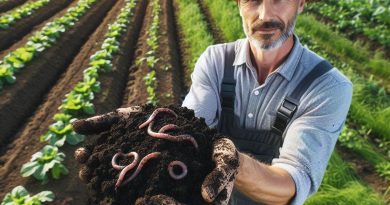Chemical-Free IPM: Pros and Cons
Last Updated on January 24, 2024
Introduction
Let’s explore chemical-free IPM: Pros and cons.
IPM is a concept that focuses on managing pests using a combination of strategies.
There is a growing interest in chemical-free IPM due to environmental concerns and health risks associated with pesticides.
In this blog post, we will discuss the pros and cons of chemical-free IPM, exploring its benefits and limitations.
We will examine alternative methods, such as biological controls and cultural practices, that can be used to effectively manage pests without relying on chemicals.
Additionally, we will address the challenges and potential drawbacks of chemical-free IPM, such as the need for frequent monitoring and the possibility of reduced efficacy.
By the end of this post, readers will have a better understanding of the advantages and disadvantages of chemical-free IPM and can make informed decisions regarding pest management strategies.
Read: Cultural Practices in IPM for Soil Health
Pros of Chemical-Free IPM
Chemical-Free IPM, or Integrated Pest Management, offers a range of benefits that make it an attractive option for farmers and workers.
By adopting methods that reduce reliance on toxic chemicals, individuals involved in agricultural activities can experience various advantages.
Health benefits for farmers and workers
One of the primary advantages of chemical-free IPM is the improvement in health for farmers and workers.
By reducing their exposure to toxic chemicals commonly used in conventional pest management, individuals can safeguard their well-being.
Exposure to pesticides and other harmful chemicals has been linked to various health problems, including respiratory issues and chronic diseases.
Therefore, by embracing chemical-free IPM, these risks can be significantly lowered.
Environmental advantages
Chemical-free IPM also offers substantial environmental benefits.
Traditional pest control methods often contribute to water pollution and contamination due to the runoff of chemicals into waterways.
However, with chemical-free IPM, the use of such toxic inputs is minimized, leading to a reduction in water pollution.
Additionally, this approach helps preserve biodiversity and beneficial organisms in the ecosystem. By preventing the indiscriminate use of chemicals, chemical-free IPM ensures a healthier and more balanced environment.
Consumer demand
Consumer preferences play a crucial role in shaping the agricultural market.
In recent years, there has been a growing interest among consumers for organic and chemical-free products.
As consumers become more conscious of the potential harmful effects of pesticides and other chemicals on their health, they are increasingly seeking out safer alternatives.
By embracing chemical-free IPM, farmers can meet the rising consumer demand for organic produce and tap into wider market opportunities.
This shift towards chemical-free practices can enable farmers to capture a niche market and potentially reap higher profits.
In short, chemical-free IPM offers numerous pros, including health benefits for farmers and workers, environmental advantages, and meeting consumer demand for organic products.
By adopting these practices, individuals can promote sustainable farming practices, protect their health, and contribute to a healthier environment.
Read: Tech Advances in IPM for Sustainability
Cons of Chemical-Free IPM
While chemical-free Integrated Pest Management (IPM) has its benefits, it also comes with some drawbacks.
In this section, we will explore the cons of implementing a chemical-free IPM approach, which includes increased labor requirements, higher production costs, and limited effectiveness against certain pests and diseases.
Increased labor requirements
One of the downsides of chemical-free IPM is the need for increased labor.
This includes regular monitoring and scouting for pests, which requires constant vigilance.
Without the aid of chemical pesticides, farmers must rely on manual pest control methods.
- Regular monitoring and scouting for pests: Without chemical treatments, farmers must actively monitor their crops for signs of pest infestations. This involves regular inspections and the constant presence of knowledgeable personnel.
- Time-consuming manual pest control methods: Chemical-free IPM relies on physical interventions such as hand-picking pests, using traps, or introducing natural predators. These methods can be time-consuming and require a dedicated workforce.
Higher production costs
Implementing a chemical-free IPM approach can lead to higher production costs.
Organic pesticides and biocontrol agents, which are essential in this system, often come with a higher price tag compared to synthetic chemical pesticides.
- Expenses associated with organic pesticides and biocontrol agents: Organic pesticides and biocontrol agents, such as beneficial insects or microbial sprays, tend to be more expensive than their chemical counterparts. These increased expenses can significantly impact production costs.
- Potential yield losses due to reduced pest control efficacy: Chemical-free IPM may not always provide the same level of pest control efficacy as chemical pesticides. This can result in potential yield losses due to pests inflicting damage on crops.
Limited effectiveness against certain pests and diseases
While chemical-free IPM can effectively control many pests and diseases, it may have limited effectiveness against certain specific pests and diseases.
- Lack of registered organic pesticides for certain crops: Some crops may not have sufficient registered organic pesticides available for effective pest management. This lack of options restricts farmers’ ability to combat pests using chemical-free methods.
- Challenges in managing specific pests and diseases: Certain pests or diseases may be particularly challenging to control using chemical-free IPM. In these cases, farmers may face difficulties in finding suitable alternatives or effective strategies.
While chemical-free IPM has its advantages, it is important to consider these cons before fully embracing this approach.
Increased labor requirements, higher production costs, and limited effectiveness against certain pests and diseases are potential challenges that farmers may encounter.
Nevertheless, with proper planning and management, these drawbacks can be mitigated, making chemical-free IPM a viable and sustainable pest control option.
Read: Natural Predators: Allies in IPM

Strategies for Successful Chemical-Free IPM
The use of chemicals in pest management has been the norm for a long time.
However, concerns about their negative impact on the environment and human health have led to the development and implementation of chemical-free integrated pest management (IPM) strategies.
These strategies aim to control pests effectively while minimizing the use of synthetic pesticides.
In this section, we will explore some of the key strategies for successful chemical-free IPM.
Crop rotation and habitat diversification
Crop rotation involves the systematic planting of different crop species in sequential seasons.
This practice disrupts pest life cycles and reduces the suitability of the habitat for pests.
By changing the crop type, pests that rely on specific host plants are deprived of their preferred food source.
This reduces their population and prevents outbreaks.
Additionally, habitat diversification plays a crucial role in chemical-free IPM.
By incorporating diverse plant species in and around the cultivated area, natural enemies of pests are attracted.
These natural enemies include predatory insects, birds, and beneficial microorganisms.
Their presence helps to control pest populations naturally, reducing the need for chemical interventions.
Biological control
Biological control involves the introduction and conservation of beneficial insects and the use of microbial agents for pest control.
Beneficial insects, such as ladybugs and parasitic wasps, prey on pests and help to keep their populations in check.
They can be introduced into the crop fields or encouraged through the creation of suitable habitats.
This method provides sustainable and natural pest control without the use of chemicals.
Microbial agents, such as bacteria, viruses, and fungi, can also be utilized in chemical-free IPM.
These agents are specific to certain pests and pose no harm to humans or beneficial organisms.
They can be sprayed directly on the plants or soil to control pests effectively. This method has gained popularity due to its effectiveness and environmentally friendly nature.
Cultural practices
Cultural practices play a significant role in chemical-free IPM by creating conditions that are unfavorable for pests.
Sanitation measures, such as the removal of crop residues and weeds, help minimize pest infestation.
Clean fields provide fewer hiding places and reduce the availability of food and shelter for pests.
Regular monitoring and removal of infected plants can also prevent the spread of diseases and pests to healthy plants.
Proper irrigation and nutrient management are crucial in maintaining crop health and reducing pest susceptibility.
Over-irrigation and excessive use of fertilizers can lead to lush plant growth, making them more attractive to pests.
Optimal irrigation practices and balanced nutrient supply help maintain the plant’s health and improve its ability to withstand pest attacks naturally.
In fact, chemical-free IPM offers an environmentally friendly and sustainable approach to pest management.
Strategies such as crop rotation, habitat diversification, biological control, and cultural practices can effectively control pests without relying on synthetic pesticides.
These strategies not only protect the environment but also promote natural pest control mechanisms.
By adopting these strategies, farmers can achieve successful pest management while minimizing the negative impacts associated with chemical pesticide use.
Read: IPM: A Farmer Guide to Eco-Farming
Conclusion
In embracing chemical-free Integrated Pest Management (IPM), advantages surface: reduced environmental impact, safeguarded biodiversity, and enhanced soil health.
Counterbalancing, challenges persist, involving potential yield fluctuations and intricate pest management.
Farmers must discern their unique landscape, climate, and crop varieties. Tailoring IPM to specific pest pressures fosters sustainability.
This approach curtails unforeseen setbacks and optimizes resource utilization.
Flexibility is key. Farmers should experiment with diverse IPM techniques—companion planting, biological controls, and habitat manipulation.
Adapting strategies based on evolving conditions ensures long-term efficacy.
In this dynamic landscape, embracing a customized IPM framework aligns with both environmental and agricultural interests.


